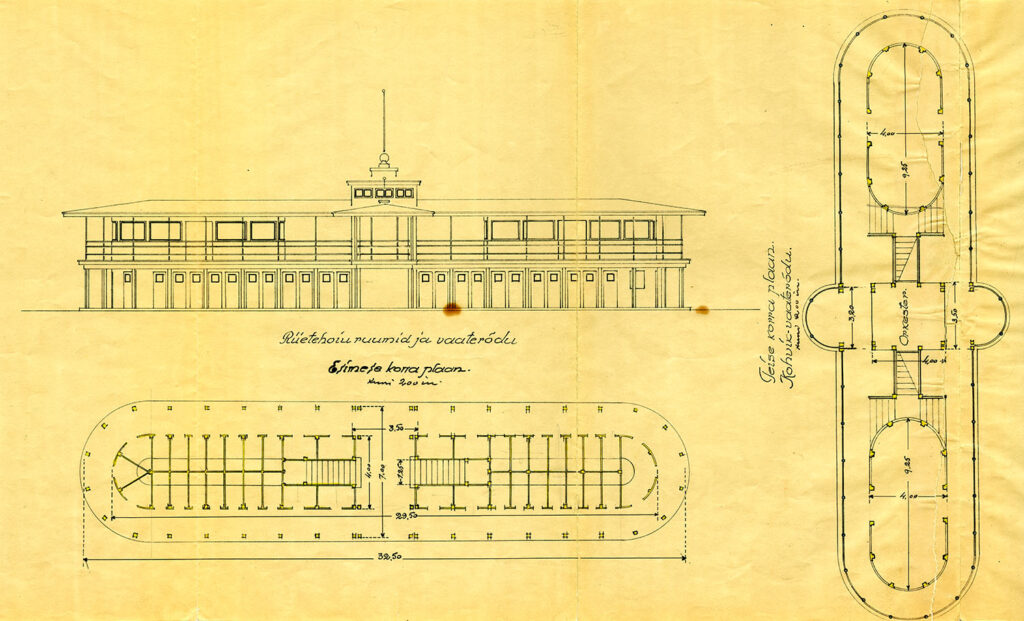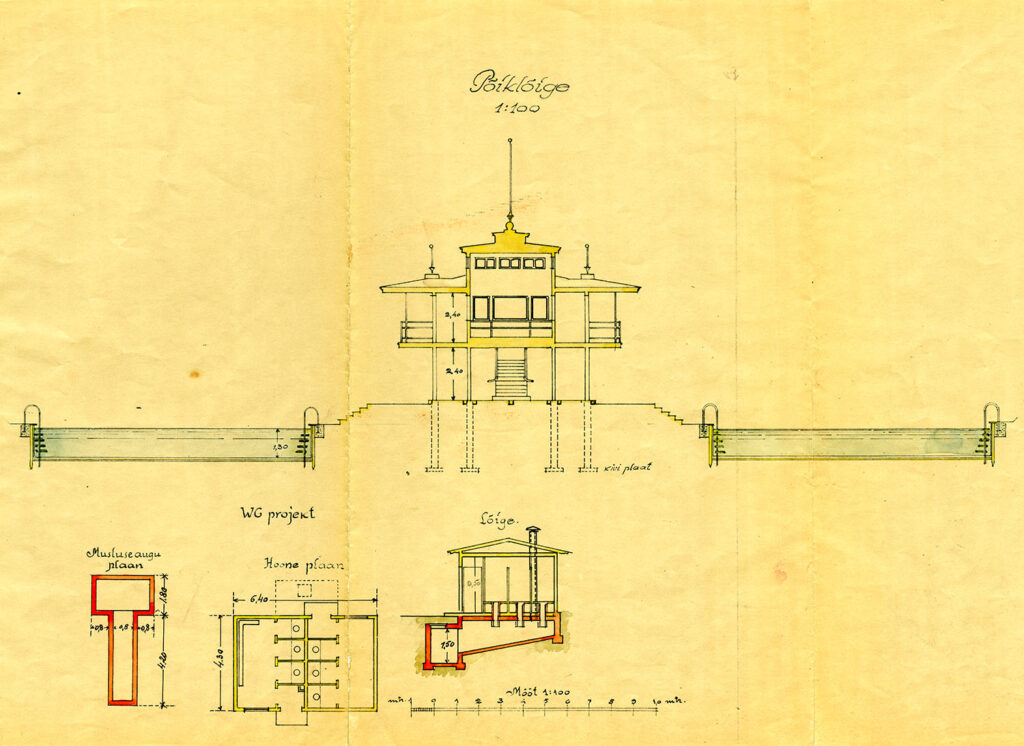Voldemar Herkel, Mai Roosna, 1965. EAM MK 174
The passenger pavilion of the Port of Tallinn
The passenger pavilion in the Port of Tallinn was opened on July 7, 1965, when the travel connection between Tallinn and Helsinki, interrupted during the war, was restored. The pavilion, designed by architects Voldemar Herkel and Mai Roosna, reflected contemporary Finnish-influenced architecture. The walls of the pavilion were formed by shields with a load-bearing steel frame, which were filled with glass or partly with wood. The floor-to-ceiling glass walls of the building opened the view to the sea; wooden shields were used on walls where, based on the function of the rooms, more privacy was needed. In contrast to the wide white cornice of the horizontal roof, the building’s clapboards were covered with dark pine tar. Building ventilation and air heating pipes were placed inside the eaves, rainwater was drained from the corners of the roof. The unity of the interior and exterior of the pavilion was also important in the design. The suspended ceiling with strip lights used in the interior moved smoothly with the same rhythm over the ceiling of the canopy, the terraces of the building and the floors of the common rooms were covered with the same dolomite tiles. The partially landscaped courtyard in the middle of the building made the interior of the pavilion more spacious and added a little greenery to the harbour environment.There was a waiting room for international travelers in the seaside part of the pavilion, and a cafe-bar operated in the back of the room. A smaller waiting room in another side of the building was intended for passengers of local ship lines. In addition, there were offices, a currency exchange point and the foreign tourism office Inturist in the pavilion. The passenger pavilion was demolished a few decades after its completion. The model of the building was made by Peet Veimer in 2008 for the exhibition “Architect and his time. Voldemar Herkel” curated by Karin Hallas-Murula. Text: Anna-Liiza Izbaš
August Volberg, Heili Volberg, 1958. EAM 31.1.37
Writers’ House
The Writers’ House in Tallinn old town was opened in the spring of 1963. The project of the four-storey building was designed by the architects August and Heili Volberg at the national design institute “Estonprojekt” in 1958. The seemingly laconic Writers’ House is characterized by the rationality typical of modernism. The regularly spaced windows indicate the different functions of the building – spaces for public use are located behind the large windows, private living spaces are hidden behind the smaller three-part windows. The building is connected to the historical architectural environment by a high pitched roof that fits the rooftop landscape of the old town. On the ground floor next to Harju Street, there was a book store called “Lugemisvara” with large display windows. On the corner of Harju and Vana-Posti streets, the cafe “Pegasus” with a modern interior design is located on three floors. A vestibule with a wardrobe and auxiliary rooms were originally planned in the first floor. On the next two floors are the halls of the cafe, the windows of which offer a view of St. Nicholas Church, the verdant green area and the Eduard Vilde monument. The floors of the cafe are connected by a spiral staircase. The premises of the Estonian Writers’ Union and a 150-seat meeting hall with an expressive black ceiling are located in the three-storey part of the building facing Kuninga Street. There was also space for the editors of the “Looming” magazine and the Literary Fund. In addition to the public function, two to five room apartments for writers and their families were planned in the building. In the larger apartments, one room was planned as a writer’s workspace. During the later reconstruction, the fifth floor of the house, under the roof, was built. Text: Anna-Liiza Izbaš
(klick on the picture to see more illustrations)
Nora Tammoja, 1964. EAM 11.1.32
Children’s park in Sindi
Landscape architect Nora Tammoja has created numerous projects for urban green areas, cemeteries and children’s playgrounds. The design of children’s park in Sindi (Sindi Lastepark) was completed in 1964, the co-author of the project was architect Kaarel Pedak. The playground included playhouses and shelters, a climbing and sledding hill with a tunnel inside, a swing area, a traffic lane, a sandbox and a Robinson square. Robinson square was a playground construction site where children could build various buildings according to their imagination. The materials needed for construction were collected from various construction sites and were placed in the material warehouse on the playground. Since construction was considered primarily a boy’s activity, a separate play area for girls was planned in the park. The girls’ playhouse consisted of several rooms, one of which had a toy stove, and there was also a shop-pharmacy. In the middle of the playground was a two-way traffic lane with crosswalks and traffic signs. In the centre of the track was a circular traffic island intended for the position of a traffic controller. Sindi Lastepark with various play elements was mainly intended for preschool children and students of younger grades. On the back side of the project photo (EAM 11.1.69), it is noted that the work was awarded a silver medal at the National Economic Achievements Exhibition in Moscow in 1964. Construction work on the children’s park began in 1965, but probably not everything planned was completed. Text: Anna-Liiza Izbaš
(klick on the picture to see more illustrations)
Heili Volberg, 1970. EAM 51.1.4
Pärnu Maritime School
In 1970, architect Heili Volberg designed an extension to the dormitory of the maritime school located by the moat in Pärnu. Spacious classrooms, an auditoorium and a sports hall, even a hairdresser’s office, was planned in the educational building. Pärnu Maritime School was closed and the project was not completed. The school dormitory was reconstructed and the Viiking health center was opened in the building at the beginning of August 1993. The boards of Pärnu Maritime School were designed by interior architect Aate-Heli Õun using the collage technique. The work was donated to the museum by architect Heili Volberg-Raig in 2013. Text: Anna-Liiza Izbaš
(klick on the picture to see more illustrations)
Tõnis Mihkelson, 1936. EAM 2.6.53
Mustamäe bathing facility
Under the lead of entrepreneur Johan Must, a bathing facility was built in Nõmme under the slope of Mustamäe. The town of Nõmme granted a construction permit for the facility in 1927, but the construction work was delayed due to land ownership disputes. In 1934, Johan Must acquired the necessary land. He received a loan from the Ministry of Economy to build a bathing facility, construction work began in the fall of 1935. Mustamäe bathing facility was designed by architect Tõnis Mihkelson. In 1936, a cafe building and a 50-meter swimming pool were completed. A year later, changing rooms, another slightly deeper pool, a water jumping tower and a swan pond were opened. In order to obtain a water temperature suitable for swimming, cold spring water was directed through four pre-heating pools, and artificial waterfalls were built to ensure water quality. A functionalist wooden cafe building was located between the two swimming pools. There were dressing rooms on the first floor, a balcony and a separate area for the orchestra on the second floor. In addition, a staircase was planned on the slope of Mustamäe, which led to Nõmme’s garden city. Domestic and international swimming competitions were held in the swimming pools, chess tournaments were regularly held in the cafe building. In winter, people could enjoy winter swimming and ice skating.The cafe building of the Mustamäe bathing facility was destroyed in 1974. Text: Anna-Liiza Izbaš
(klick on the picture to see more illustrations)
Veljo Kaasik, 1982. EAM K 31
Dialogue “Client-architect”
“Client-architect” by Veljo Kaasik is a visual dialogue between the architect and the client. The work depicting the design process of a private house located on Nisu Street in Tartu shows how the building is completed in cooperation between an ambitious architect and a demanding client. Both parties are connected to each other from the planning of the building until its completion. The architect’s imaginative ideas are often influenced by the different sense of aesthetic and disagreements of the parties involved. Mostly, compromises are made. The final result is more or less different than originally planned. Veljo Kaasik’s work was on display at the exhibition of ten architects in the salon of the Tallinn Art Hall Gallery (exhibition 23.12.1982–9.01.1983). Text: Anna-Liiza Izbaš
Anton Soans, Edgar Johan Kuusik, 1932-1933. EAM 16.1.39
Sketches of the facade of the Tallinn Art Hall
Designed by architects Anton Soans and Edgar Johan Kuusik, the Tallinn Art Hall is one of the most outstanding examples of functionalism in Estonia. In order to find the most suitable facade design, the architects sketched different solutions – the drawings show different designs for the entrance to the building, the arrangement of windows and the details on the facade. The facade solution of the building also changed slightly during the construction works, when the initially planned round windows were replaced with vertical niches. The cornerstone of the Tallinn Art Hall was laid on August 29, 1933, and it was officially opened with an art exhibition on September 15, 1934. The modernity of the originally five-storey building with a T-shaped ground plan is emphasized by the main entrance of the building that is stepping back from the street line and the central part of the front facade that is resting on two pillars, as well as the flat roof of the building. The glass screen located in the middle of the facade, as if placed inside a frame, connects the artists’ studios, office spaces and exhibition hall located on different floors on the facade into one. In 1937, the bronze figures “Work” and “Beauty” designed by the sculptor Juhan Raudsepp were placed in the niches of the facade. According to the project of Edgar Johan Kuusik, the last floor of the Art Building was rebuilt in 1962, as a result of which the building became as high as the adjacent Art Foundation building (architect Alar Kotli). In 1993, Ado Soans, son of Anton Soans, donated the facade drawings to the museum. Text: Anna-Liiza Izbaš
(klick on the picture to see more illustrations)












